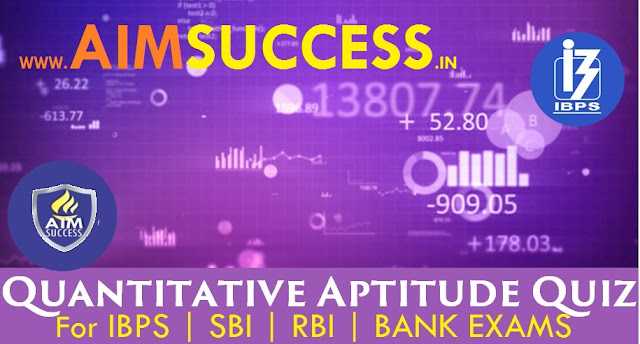Quantitative Aptitude Quiz for IBPS PO/RRB
Directions (Q. 1-5): In each of the following questions a number series is given. What will be the next term of the series?
1. 5 13 29 61 125 253 ?
1) 506
2) 509
3) 378
4) 500
5) None of these
2. 4 5 14 10 24 15 ?
1) 36
2) 43
3) 34
4) 32
5) None of these
3. 2 3 10 39 172 885 ?
1) 5364
2) 1170
3) 5310
4) 5136
5) None of these
4. 3 8 30 ? 680 4110
1) 156
2) 136
3) 132
4) 148
5) None of these
5. 5 6 11.25 26.5 72.5 226.5 ?
1) 679.5
2) 729.75
3) 797.75
4) 792.75
5) 805
6. A, B and C can finish a work in 10 days, 15 days, and 12 days respectively. If they work successively for one day each then in how many days will the work be completed?
1) 4 days
2) 15 days
3) 18 days
4) 12 days
5) Data inadequate
7. The population of a country, according to the 2011 census, was 2,567,950. Since 1981 it had increased by 10, 15 and 40 per cent respectively through successive decades to reach the 2011 census figure. What was the population of the country in 1981?
1) 1,450,000
2) 1,500,000
3) 1,600,000
4) Data inadequate
5) None of these
8. Rajat spends 17% of his monthly income on Rent. He spends 25% of his monthly income on savings and 36% of his monthly income on household articles. He has remaining amount of Rs 10032 left. What is his annual income?
1) Rs 550300
2) Rs 536500
3) Rs 547200
4) Can’t be determine
5) None of these
9. In how many different ways can the letters of the word ‘EXPECTED’ be arranged?
1) 6612
2) 6720
3) 6780
4) 6650
5) None of these
10. The length of a rectangular floor is twice its breadth. If Rs 256 is required to paint the floor at the rate of Rs 2 per squar metre, then what would be the length of floor?
1) 16 metres
2) 8 metre
3) 12 metre
4) 32 metre
5) 20 meter
11. Four persons A, B, C and D run along a 16 km long circular path. They start their race from the same point and at the same time with speed of 4 km/hr 5 km/hr, 6 km/hr and 7 km/hr respectively. After what time will they meet again?
1) 20 hrs
2) 32 hrs
3) 8 hrs
4) 16 hrs
5) None of these
12. Two alloys A and B contain gold and silver in the ratio 1 : 2 and 3 : 4 respectively. A third alloy C is formed by mixing A and B in the ratio 5 : 6. Find the percentage of silver in the alloy C.
1) 60%
2) 61%
3) 62%
4) 39%
5) None of these
13. If A : B = 1 : 2; B : C = 3 : 4; C : D = 5 : 6; D : E = 7 : 8; then A is approximately what percentage of E?
1) 26.34%
2) 27.34%
3) 28.34%
4) 27.43%
5) None of these
14. A bucket contains a mixture of two liquids A and B in the proportion 7 : 5. If 17 litres of the mixture is replaced by 17 litres of liquid B, then the ratio of the two liquids becomes 1 : 1. How much of the liquid A was there in the bucket?
1) 49 5/12litres
2) 49 7/12 litres
3) 67 5/12 litres
4) 119 litres
5)69 5/12 litres
15. A, B and C enter into a partnership. A advances one-fourth of the capital for one-fourth of the time. B contributes one third of the capital for one-third of the time. C contributes the remaining capital for the whole time. A profit of Rs x is divided among all the three persons. C’s share is what per cent of the sum of the shares of A and B?
1) 240%
2) 140%
3) 60%
4) 48 1/3%
5) None of these
Answers:
- 2
- 3
- 5
- 3
- 5
- 4
- 1
- 3
- 2
- 1
- 4
- 5
- 2
- 5
- 1











